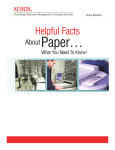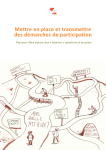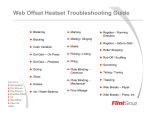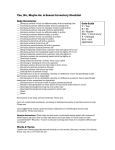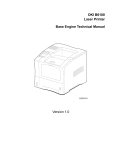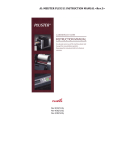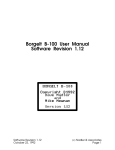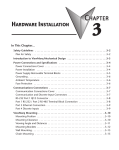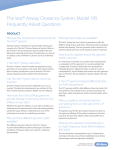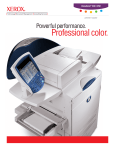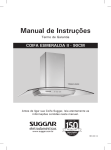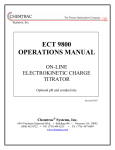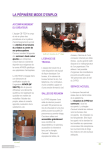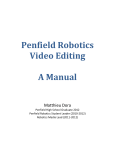Download sequential
Transcript
Technical service handbook for Suzano papers ⌠ issue 1 ⌡ Introduction ............................................................................................................................................................................................................ 3 1 Technical information .................................................................................................................................... 4 Numbering system for rolls ........................................................................................................................................................................ 5 Numbering system for skids ...................................................................................................................................................................... 6 Storage and conditioning recommendations..................................................................................................................................... 7 Creasing rules and counterparts recommendations ....................................................................................................................... 9 Paperboard classification ..........................................................................................................................................................................11 Main technical properties ..........................................................................................................................................................................12 Conversion factors and calculator tools ..............................................................................................................................................15 Main statutes concerning paper and paperboard ..........................................................................................................................16 2 Troubleshooting.......................................................................................................................................... 17 Cigarette roll ...................................................................................................................................................................................................19 Irregular edge cut .........................................................................................................................................................................................20 Edge debris ......................................................................................................................................................................................................21 Picking ...............................................................................................................................................................................................................22 Hickeys ..............................................................................................................................................................................................................23 Blade lines ........................................................................................................................................................................................................24 Coating impurities and other defects ...................................................................................................................................................25 Stains and other marks on surface ........................................................................................................................................................26 Felt mark on surface.....................................................................................................................................................................................27 Mottling ............................................................................................................................................................................................................28 Cracks on the surface ..................................................................................................................................................................................30 Delamination between layers ..................................................................................................................................................................31 Delamination during die cutting and creasing .................................................................................................................................32 Blistering ...........................................................................................................................................................................................................33 Size variation or incorrect size .................................................................................................................................................................34 Slack edges or baggy rolls ........................................................................................................................................................................35 Creases or wrinkles .......................................................................................................................................................................................36 Piping or moisture welt ..............................................................................................................................................................................37 Splice or joint ..................................................................................................................................................................................................38 Wrapping glue ...............................................................................................................................................................................................39 Core related problems ................................................................................................................................................................................40 Dimensional instability or curl on copy paper ..................................................................................................................................41 Dimensional instability or curl on paperboard and offset ...........................................................................................................43 Conclusion .............................................................................................................................................................................................................45 suzano technical service handbook version 01/10/2013 Page 2 Introduction Suzano technical service team strives to offer you its best helping you to use our papers in the optimum conditions. We wrote this handbook to gather information that may help you in your day to day experience with Suzano products. This starts with tips to read the numbering system we have adopted for rolls and skids. Recommendations concerning the storage and conditioning of our products will help you to keep them ready once you need them. In order to take advantage of the Suzano paperboard construction, we have included creasing rules and counterparts recommendations. Despite each of us do our best to use the products, problems may happen. Troubleshooting instructions will allow you to go through these problems and gather information and evidences that will help Suzano to investigate the causes. Finally, we thought interesting to include our claim policy as well as general information concerning paperboard classification, paper technical properties and common conversion factors. If you think we should include other information here that might be helpful for our customers, feel free to contact your local Suzano technical service team! Page 3 suzano technical service handbook version 01/10/2013 1 Technical information suzano technical service handbook version 01/10/2013 Page 4 Numbering system for rolls The Suzano roll number is a 14-digit number. It is important to identifying the potential source of paper problems. Indeed, it contains information such as the mill, the papermachine used, the date, the set and the roll position. Besides, knowing the roll numbering can help you to logically warehouse the reels for their future use in a logical way. To minimize press settings, the reels can then be used in the sequence of their manufacture and reel position. MILL INFO MONTH SZ Suzano, SP Even-numbered years Odd-numbered years MU Mucurí, BA A January N January RP Limeira, SP B February P February EM Embú, SP C March Q March SZ Rio Verde, SP D April R April E May S May F June T June ROLL POSITION G July U July The reel that is closest to the H August V August Front J September W September papermachine has position K October X October number 001. Higher is the L November Y November position closer to the Drive M December Z December side it is. SET NUMBER Each set of rolls coming off the winder are sequentially, numbered starting every day at 12:00 a.m. side of the Roll numbering example: Page 5 suzano technical service handbook version 01/10/2013 Numbering system for skids The Suzano skid numbering is a 12 digit number. It is important to identifying the potential source of paper problems. Indeed, it contains information such as the mill, the sheeting machine used, the date and the set. Besides, knowing the numbering can help you to logically warehouse the pallets for their future use in a logical way. To minimize press settings, the pallets can then be used in the sequence of their manufacture. MILL INFO MONTH SZ Suzano, SP Even-numbered years Odd-numbered years MU Mucurí, BA A January N January RP Limeira, SP B February P February EM Embú, SP C March Q March SZ Rio Verde, SP D April R April E May S May F June T June G July U July H August V August J September W September K October X October L November Y November M December Z December suzano technical service handbook version 01/10/2013 SET NUMBER Each skid coming off the sheeter is numbered sequentially, starting every day at 12:00 a.m. Page 6 Storage and conditioning recommendations Paper, by nature, is hygroscopic. It will pick up moisture from its environment and it will release moisture into the environment to try to reach equilibrium with the moisture in the air surrounding it. As a result, cellulose fibres increase in size or get smaller. This expansion or contraction is not uniform. This physical characteristic is a property to which the paper user must adapt. Even if it is not always easy to practice, we recommend all our customers to consider these points: The ideal humidity of the warehouse and the press room is 50-55% relative humidity at an ideal temperature of 20°C to 25°C (68°F to 77°F). Paper should be stored away from heaters, cold walls and sheltered from the wind. Avoid damaging the paper wrapping and carefully re-wrap damaged ones. Paper should be used on a first-in-first-out basis. Make sure the paper, still wrapped, is acclimatized to where it is going to be converted or printed. The necessary time for acclimating is generally between 24-48 hours. Remove the wrapping just before printing or converting. The wrapping protects the paper from moisture exchange and also from dirt and damage. Re-wrap the paper after converting, printing or during further storage. Use moisturising installations whenever possible in the paper storage area and print room. Indeed, during the winter, relative humidity drops to very low levels, especially if heaters are used. Moisturising equipment helps to maintain ideal humidity of the warehouse and the press room. Reel or skid weight Page 7 Temperature difference 5°C (10°F) 10°C (20°F) 15°C (30°F) 20°C (50°F) 400 kg (882 lb) 0.5 day 1 day 1 day 2 days 600 kg (1'323 lb) 1 day 1.5 days 1.5 days 2.5 days 800 kg (1'764 lb) 1.5 days 2 days 2.5 days 3 days 1'000 kg (2'205 lb) 1.5 days 2 days 3 days 3.5 days suzano technical service handbook version 01/10/2013 Besides, when it comes to copy paper, we would like to recommend all our customers to consider these points: Storage temperature should optimally be 20°C to 25°C. The relative humidity should be between 50% and 55% (68°F and 77°F). Leave paper in the wrapper until you are ready to load the paper tray of the copier or printer. The wrapper protects the paper from absorbing moisture. For optimal performance, store unused paper in a sealed bag. Do not store the paper in the printer or copier paper trays. Do not store paper directly on the floor to avoid moisture absorption. When moving paper from one location to another where the temperature and humidity differ, allow the paper to condition in the new location per the chart below. Do not open the reams until the paper is ready to use. 2 Temperature difference # of boxes (75g/m ) 5°C (10°F) 10°C (20°F) 15°C (30°F) 20°C (50°F) 1 4 hours 10 hours 17 hours 24 hours 5 5 hours 12 hours 18 hours 25 hours 10 8 hours 18 hours 27 hours 38 hours 20 11 hours 23 hours 35 hours 48 hours 40 14 hours 26 hours 38 hours 54 hours Look for the icon on the paper tray of the printer showing which side will print first. Load the paper tray according to the ream wrapper arrow for best results and to avoid excessive curl. If the paper is jamming, fan the paper as needed to prevent the edges from sticking together. The Suzano skid numbering is a 12 digit number. It is important to identifying the potential source of paper problems. Indeed, it contains information such as the mill, the sheeting machine used, the date and the set. Besides, knowing the numbering can help you to logically warehouse the pallets for their future use in a logical way. To minimize press settings, the pallets can then be used in the sequence of their manufacture. suzano technical service handbook version 01/10/2013 Page 8 Creasing rules and counterparts recommendations CREASING RULES THICKN ESS: Thickness (f) of the creasing rules is determined by the paper thickness (e). Recommended thickness (f) Thickness (e) of the creasing rule (1 pt = 0,35mm) CREASING 0,1 – 0,8 mm 2 pts 0,6 – 2 mm 3 pts RULES HEIGHT : Height of the creasing rules (h) to be used depends if counterparts are engraved in the cutting die or if prefabricated creasing counterparts are used. h = H = 23,8 cm h=H-e h=H-e-a Page 9 suzano technical service handbook version 01/10/2013 CREASING COUNTERPARTS DEPTH: Thickness of creasing counterparts (d) is determined by paper thickness (e) and thickness of the channel bottom (a). d=e+a CREASING COUNTERPARTS GROOVE WIDTH: The width of groove (b) is dependant of the fibres direction. It is determined by paper thickness (e) and thickness of the creasing rule (f). Grooves perpendicular to the sheet fibers: b = (1,5 x e) + f Grooves parallel to the sheet fibers: b = (1,3 x e) + f suzano technical service handbook version 01/10/2013 Page 10 Paperboard classification The term “paperboard” can refer to a wide variety of board. The German Institute for Standardization or Deutsches Institut für Normung (DIN) defined a standard: DIN 19303 "Paperboard - Terms and grades" to classify the different ranges of paperboard based on their surface treatment, furnishes and color of the reverse (non-D board) or bulk (D board only). First letter Second letter Third letter (surface treatment) (main furnish) (Color of the reverse / bulk) All board except those A = cast-coated G = pigment coated U = uncoated Z = bleached virgin chemical pulp classified as “D”: C = virgin mechanical pulp 1 = white reverse N = unbleached virgin chemical 2 = cream reverse pulp 3 = brown reverse T = recycled fibre with white, cream or brown reverse Boards classified as “D”: D = recycled fibre with grey 1 = bulk ≥ 1.45 reverse 2 = 1.3 < bulk < 1.45 3 = bulk ≤ 1.3 In our product specification sheets, all the different paperboards are classified based on this standard. As an example: Classification Ex.: TP White® (GC1) G = pigment coated C = virgin mechanical pulp 1 = white reverse = Paperboard containing as main furnish virgin mechanical pulp, coated and white reverse Other classifications exist; including regionals that are based on a local grade supply (ex. art board, ivory board…) and non-standards those are less detailed (ex. SBB, SBS, FBB, WLC, duplex…). One has to be very careful when comparing different paperboard to avoid confusion. Page 11 suzano technical service handbook version 01/10/2013 Main technical properties All products we sell have a technical specification sheet listing the main parameters the paper has and for each of these parameters, a nominal value and tolerance. All these parameters are given for a specific temperature and relative humidity condition, based on ISO 187:1990 - Paper, board and pulps -- Standard atmosphere for conditioning and testing and procedure for monitoring the atmosphere and conditioning of samples. This standard test climate condition and a specific standard for each parameter guarantee the confidence, repeatability and comparison of the measures made every day in our mills. Grammage (ISO 536) It is expressed in g/m², and is the weight in grams of a product sheet having an area equal to 1 m². The grammage influences the other product properties such as thickness, opacity and printing performance in conversion and final use equipment. However, it also influences the papermaking process. This is why the grammage is one of the parameters controlled by on-line sensors in the papermachine in addition to manual tests done at the laboratory. Grammage is one of the most important parameter to control as it is directly linked to the total printed area obtained. As an example: Paperfect Offset® 60g/m2 = Paperfect Offset® 63g/m2 = Thickness (ISO 534) It is expressed in millimeters (mm) or microns (µm, a thousandth part of millimeter). Thickness is the perpendicular distance between the sides of the product sheet. Its evenness on the cross direction (CD) and machine direction (MD) ensures printing uniformity and performance in the conversion processes. Like the grammage, this is also one of the parameters controlled by on-line sensors in the papermachine in addition to manual tests done at the laboratory. 2 When thickness value (in µm) is divided by the grammage (in g/m ), it results the bulk (or yield) of the paper. Bulk helps to compare how compact are different papers with the same grammage. suzano technical service handbook version 01/10/2013 Page 12 Opacity (ISO 2471) This is the measure of how transparent is a paper. Indeed, when a light ray comes into contact with the paper surface, part is reflected, part is absorbed and part is transmitted through the product. The more the paper absorbs the light, the more it is opaque. On the contrary, the more the light is transmitted through the paper, the more the paper is transparent. Opacity is expressed in % where 100% stands for a paper completely opaque and 0% for a paper completely transparent. As we might think, the scale is not based on transmitted light but on reflected light. ( ) R0 is the reflectance of a single sheet with black backing and R∞ is the reflectance of a single sheet with multiple sheet backing. In practical, an experienced observer cannot see an opacity difference of less than 1%. CIE Whiteness (ISO 11475) White is not different from any other color and can be technically identified in the L*a*b* color space system. However, it is common to identify the whiteness of a paper with a single number based on the entire visible spectrum, unlike brightness that is the reflectance of the blue light. In the case of a paper perfectly white, the entire visible spectrum is reflected and the CIE Whiteness = 100. In fact, thanks to the use of optical brightening agents, it is frequent to find paper with whiteness exceeding 100. In practical, an experienced observer cannot see an CIE whiteness difference of less than 2,5. When comparing the CIE Whiteness between papers, we must pay attention to the illuminant used. Indeed, even if the CIE Whiteness according to ISO 11475 is the only one commonly used (illuminant D65), some papermakers may refers to CIE Whiteness according to ISO 11476 (illuminant C). These two CIE Whiteness cannot be correlated. ISO Brightness (ISO 2470-1) Brightness identifies the whiteness of a paper with a single number based on the blue light reflectance (C illuminant) and ignores the upper two-thirds of the visible spectrum (yellow and red portions); unlike the CIE Whiteness that is the reflectance of the entire visible spectrum (D65 illuminant). When comparing the brightness between papers, we must care to always compare brightness measured under the same equipment (diffuse geometry or directional geometry) and same illuminant (C or D65). Indeed, different standards exist and cannot be correlated. Brightness Illuminant Standard ISO (C) brightness C ISO 2470-1 / TAPPI 525 ISO (D65) brightness D65 ISO 2470-2 TAPPI brightness C TAPPI T452 Note: it is sometimes common to define the brightness scale using the instrument manufacturer. For example, “Elrepho D65” will refer to ISO (D65) brightness – standard ISO 2470-2. It is admitted people can normally see a difference in brightness greater than 0,5. However, brightness is not a linear function. A change from 82 to 88 brightness has much more visual impact than a change from 88 to 94 brightness. Bendtsen Roughness (ISO 8791-2) Different methods exist to measure how smooth the surface of a paper is. For uncoated paper, the most commonly used is the Bendtsen Roughness. The principle is to measure the air leakage between the paper surface and the Page 13 suzano technical service handbook version 01/10/2013 instrument surface in a specific period. Result is displayed in ml/min. Smoother the paper surface is, less the air leakage is in a specific period. Short fibers produce smoother papers than long fibers. The other factors influencing smoothness are the mineral charges content and calander pressure intensity. A smoother product will result in vibrant printing, better varnishing and lamination. However, it can affect the press feeding efficiency and may lead to set-off problems after printing. PPS Roughness (ISO 8791-4) This is the most commonly used method for measuring the roughness of coated paper. Indeed, compared to an uncoated paper, the coating color applied on the paper surface reduces drastically the roughness which cannot be any more measured by the Bendtsen equipment. The PPS tester, which stands for Parker Print-Surf, applies a higher pressure level on the sheet surface, equivalent to the pressure applied on the sheet by the printing press. The test result is expressed as an average of the surface profiles in micrometers (µm). Low results show smooth surface while high results indicate poor surface. Moisture (TAPPI 412) This is the quantity of water the product contains expressed as a percentage of total weight. Like the grammage and the thickness, this is the third parameter controlled by on-line sensors in the papermachine in addition to manual tests done at the laboratory. Taber stiffness (TAPPI 489) This is the capacity of the paper to resist flexion force. Because of the anisotropy of the paper and fibres characteristics, its capacity to resist will be different in the Machine Direction (MD) and Cross Direction (CD). This parameter is fundamental for the use of the paper, principally for the packaging application. Different techniques exist to measure the stiffness of a paper. The most widely use is the Taber stiffness tester: a paper sample is bent at 15° and the moment required is registered and displayed in gf.cm or mN.m Even if the Taber stiffness is normally disclosed for Machine direction and Cross direction, it is also common to communicate on the geometric mean stiffness to make comparison of stiffness between different papers easier. As an example: TP White® 340 G/M2 Taber stiffness MD: 40,5 mN.m Taber stiffness CD: 16,4 mN.m → Geometric mean stiffness: √ = 25,77 mN.m Theoretically, stiffness varies in accordance with the third power of thickness, that is, if thickness is doubled the stiffness increases eight times. However, there are other parameters that have an influence on the stiffness, such as grammage, refining intensity of the different pulps used in the paper, the type of pulps and fibres selected as well as the moisture. suzano technical service handbook version 01/10/2013 Page 14 Conversion factors and calculator tools Depending on the standards and equipment used to analyze paper properties and countries where they have been measured, units can be different and this is why this conversion factors table may help you. Properties Grammage / Basis weight Paperboard (12 x 12 – 1000 sheets) Offset (25 x 38 – 500 sheets) 2 2 2 1 lb/1000ft = 4.8824 g/m 2 1 g/m = 0,2048 lb/1000ft 2 2 1 lb = 1.48 g/m 1 g/m = 0,6756 lb Thickness / Caliper 1 mil (or point) = 25.40 µm 1 µm = 0,0394 mil (or point) Taber stiffness 1 gf.cm = 0.0981 mN.m 1 mN.m = 10.1934 gf.cm 2 2 2 -3 Scott bond interlayer strength 1 lb.ft/in = 2 103 J/m 1 J/m = 4,755 x 10 lb.ft/in Temperature 1 °F = -17.22 °C 1 °C = 33,8 °F Length 1 inch = 2.54 cm 1 cm = 0,3937 inch Weight 1 pound = 0.4536 kg 1 kg = 2,2046 pounds 2 Reel length calculation Where D = outside diameter of reel [mm] d = outside diameter of core [mm] e = thickness of the paper [µm] → ( ) L = length of the reel [m] Outside diameter of reel Where D = outside diameter of reel [mm] d = outside diameter of core [mm] e = thickness of the paper [µm] → √ L = length of the reel [m] Net weight of reel Where M = net weight of reel [kg] D = outside diameter of reel [mm] d = outside diameter of core [mm] e = thickness of the paper [µm] → ( ) w = width of the reel [mm] 2 g = grammage [g/m ] Page 15 suzano technical service handbook version 01/10/2013 Main statutes concerning paper and paperboard Here is a non-exhaustive list of the typical systems that apply to paper and paperboard. ISO 9706 on requirements for permanence of paper documents: This standard is set for papers (not applicable to boards) and specifies the requirements for long life paper in term of pH value, tear resistance, alkali reserve and lignin amount. European Directive 2009/48/EC on the safety of toys: One of the objectives of Directive 2009/48/EC is to guarantee the safety of toy users and lists requirements to be met at the manufacturing stage, also known under standard EN 71. European Directive 94/62/EC on packaging and packaging waste: The main purpose is to prevent or reduce the impact of packaging and packaging waste on the environment. As an example, it restricts the presence of certain heavy metals in packaging: mercury (Hg), lead (Pb), hexavalent chromium (Cr6+) and Cadmium (Cd). A similar legislation has been adopted by several states in US, known as Model Toxics in Packaging Legislation from CONEG. European Regulation (EC) No. 1935/2004 on materials and articles intended to come into contact with food: This regulation defines the rules that apply to groups of food contact materials like paper and board to guarantee their safety when intended to come into contact with food stuffs. As an example, article 3 states materials intended to come into contact with food must not transfer their components into food in quantities that could endanger human health, change food composition in an unacceptable way or deteriorate its taste and odour. In the United States, the paper and board materials intended to come into contact with food are regulated by the Food and Drug Administration (FDA) in the Code of Federal Legislation (CFR): 21 CFR 176 Indirect food additives: Paper and paperboard components. European Regulation (EC) No 1907/2006 concerning the Registration, Evaluation, Authorization and Restriction of Chemicals (REACH): REACH regulation defines a set of rules for the production and the use of chemical substances, and their potential impacts on both human health and the environment. A list of Substances of Very High Concern (SVHC) is regularly updated and expanded by ECHA, the European Chemical Agency. To sell or use these substances, manufacturers, importers and retailers in the European Union (EU) must apply for authorization from the ECHA. European Regulation (EU) No 995/2010 laying down the obligations of operators who place timber and timber products on the market: Unlike voluntary certification schemes, such as FSC or PEFC, the European Union Timber Regulation (EUTR) makes it an offence to place illegal timber or timber products on the EU market and any company that cannot demonstrate compliance runs the risk of being driven out of the market. EUTR places obligations on those who first place such products on the market, as well as those trading further down the supply chain. The USA Lacey Act and the Australian Illegal Logging Prohibition Act are also setting similar legal frameworks. suzano technical service handbook version 01/10/2013 Page 16 2 Troubleshooting Page 17 suzano technical service handbook version 01/10/2013 In this section, you will find a description of some of the most common problems claimed and suggestions to face them. As soon as the problem seems to be related to the paper, the converter or the printer should immediately notify the Suzano merchant. In case of complaint to Suzano, in addition to basic information listed below, each problem descriptions contains a list of additional information and samples to forward us in order to get a fast and objective attendance. A claim form questionnaire is at your disposal to facilitate the process. Do not hesitate to contact Suzano representative for information. Basic information to always provide in case of complaint: Customer claim number Customer information (name, email and end user name) Suzano invoice number Product information (product name, basis weight, format, quantity invoiced) Mill order/Item numbers from label Product serial number(s) and quantities claimed (used and unused) If applicable, information regarding additional costs to reimburse (involved equipment, hours and costs/hour, evidences) Detailed information of the problem and all the involved technical processes previous to the point where it was identified Environmental and climate conditions paper product conditioning prior to job execution in warehouses, press rooms and converting facilities For further details or help, we suggest you to read Suzano claim policy document and always feel free to contact your local Suzano technical representative. suzano technical service handbook version 01/10/2013 Page 18 Cigarette roll Description Surface of the sheet is delaminating in a “V” shape and rolls up from one of the sheet edge, causing rubber blanket damages when going through an offset press. It may be explained or by a poor surface strength of the paper; or because of too strong friction between two sheets during sheeting or guillotine cutting stages. Recommendations - Check if any undesirable friction on the paper or between the sheets may occur during the sheeting or trimming operation. - Ask the mill to check surface strength of the paper (IGT or Dennison number). Additional information and samples needed (+ basic info. page 18) Page 19 No photo needed. Minimum 24 sequential and original size delivered unprinted sheets to evidence the cigarette roll(s) and allow the mill to measure the surface strength of the paper. If paper supplied in reels, 2m length of paper is requested. 12 sequential printed sheets before the cigarette roll(s) and 12 sequential printed sheets after the cigarette roll(s) to show possible blanket damages effect. If applicable, sample(s) of damaged blanket(s) and copy of its invoice for compensation. suzano technical service handbook version 01/10/2013 Irregular edge cut Description Edge(s) of the ream, skid or reel shows irregular cutting quality which may lead to misfeeding, jamming or unsightly aspect of the paper. Recommendations - Fan the paper stack before loading. - Trim the sheets on defective edge(s). - Rotate the sheets at 180° and feed the press again. - Turn over the sheets and print the other side first. - Reduce press speed. - Replace the paper with a different making order. Additional information and samples needed (+ basic info. page 18) Photos from ream, skid or reel edges showing the irregular cut. Minimum 24 sequential and original size delivered unprinted sheets to evidence the irregular cut. If paper supplied in reels, 2m length of paper is requested. No printed sample needed. No extra sample needed. suzano technical service handbook version 01/10/2013 Page 20 Edge debris Description Edge(s) of the ream, skid or reel shows loose fibers which adhere to the blanket, causing voids or hickies on printed sheets when going through the 1st units of a press. It can be explained by a poor chop, slitter or guillotine cutting. Recommendations - Check if vacuum extraction and ionizing systems are on and well adjusted. - Wipe the edge(s) to remove loose fibers or dust particles. - Modify the printing sequence in order to run the first unit empty or with a low coverage print. - Increase the wash-up frequency. - Trim the sheets on defective edge(s). - Replace the paper with a different production position or order. Additional information and samples needed (+ basic info. page 18) Page 21 Photos from ream, skid or reel edges showing the dust particles. Minimum 24 sequential and original size delivered unprinted sheets to evidence the edge debris. If paper supplied in reels, photo of the reel edge showing dust particles. Minimum 24 sequential printed sheets with defect circled. Adhesive tape pull of loose fibers removed from the paper edges or from the blanket. suzano technical service handbook version 01/10/2013 Picking Description Coating or fibre particles are pulled from the paper surface, adhere to the blanket, causing voids or craters on the surface and hickies on following printed sheets. It can be explained by poor paper surface strength or by a very tacky ink. Recommendations - Check if the problem is related to edge debris. If it is the case, follow previous recommendations given for. - Reduce press speed to decrease the forces applied on the paper. - Reduce impression cylinder pressure. - Increase the wash-up frequency. - Reduce ink tack adding gel or varnish. - Run once the paper only with pressure and fountain solution but without printing. - Replace the paper with a different production. Additional information and samples needed (+ basic info. page 18) No photo needed. Minimum 24 sequential unprinted sheets cut to A4/A3 size to allow the mill to measure the surface strength of the paper. If paper supplied in reels, 2m length of paper is requested. Minimum 24 sequential printed sheets cut to A4/A3 size with defect circled. Adhesive tape pull of dust particles removed from the blanket. suzano technical service handbook version 01/10/2013 Page 22 Hickeys Description Hickeys may results from picking or from external contaminants: ink, rubber, dust… Recommendations - Check if picking may be observed on previous sheets printed. If yes, follow recommendations given for picking problem. - Inspect the blanket, remove and identify origin of the contaminant. - If it is dry ink particles, make sure all sources of dry ink contamination are erased: tins of ink closed; no stagnant ink in the fountain in contact with the air; dusts on blades or rollers… - If it is rubber particles, inspect the blanket and rollers, make sure they are not damaged or worn out. If it is the case, change them. - If dust, make sure the paper stack didn’t stay too long time without wrapping/dust protection and check if the press room is clean: floor, walls, roof, equipment, air conditioning system… Additional information and samples needed (+ basic info. page 18) Page 23 No photo needed. Minimum 24 sequential unprinted sheets cut to A4/A3 size to allow the mill to measure the surface strength of the paper. If paper supplied in reels, 2m length of paper is requested. Minimum 24 sequential printed sheets cut to A4/A3 size with defect circled. Adhesive tape pull of dust particles removed from the blanket. suzano technical service handbook version 01/10/2013 Blade lines Description Single or various lines/streaks can be observed on the coated surface, always in the grain direction. These lines can vary a lot in width and length. Recommendations - Stop using the reel or pallet and contact immediately Suzano representative for replacement or agreement to continue running the job with the defective paper. Additional information and samples needed (+ basic info. page 18) No photo needed. Minimum 16 unprinted sheets cut to A4/A3 size to evidence the defect. Printed or converted sheets cut to A4/A3 size with defect circled. No extra sample needed. suzano technical service handbook version 01/10/2013 Page 24 Coating impurities and other defects Description Coating impurities and other related defects are most of the time concentrated on a very short quantity of sheets but may cause severe damages on the press. Recommendations - Sort out defective sheets and inspect possible damaged caused on the blankets or plates. - Pay extra attention to the remaining quantities of sheets from the defective delivery before or during printing. Additional information and samples needed (+ basic info. page 18) No photo needed. Defective sheets to evidence the defect. Defective sheets to evidence the defect. Page 25 If applicable, sample(s) of damaged blanket(s) / plate(s) and copy of its invoice for compensation. suzano technical service handbook version 01/10/2013 Stains and other marks on surface Description Stains and other marks (visible or not) on unprinted sheets affect the visual aspect of the sheet once printed. Recommendations If the stains can be seen on sheets in sequence and have the same position on sheets, check the printing equipment. Sort out defective sheets and pay extra attention to the remaining quantities of sheets from the defective delivery before or during printing. Additional information and samples needed (+ basic info. page 18) No photo needed. Minimum 24 sequential unprinted sheets cut to A4/A3 size to allow the mill inspect the surface of the paper. If paper supplied in reels, 2m length of paper is requested. Minimum 24 sequential printed sheets cut to A4/A3 size with defect circled. No extra sample needed. suzano technical service handbook version 01/10/2013 Page 26 Felt mark on surface Description Felt mark is a defect that only occurs on uncoated papers. Its appearance is very characteristic and can be caused by an uneven sheet formation or too high penetration of inks. Recommendations - Reverse ink sequence to print with the most tacky ink first. - Print the solid colours in the latest units. - Increase press speed or reduce impression cylinder pressure. - Print paper on reverse side. - Replace the paper with a different production position or order. Additional information and samples needed (+ basic info. page 18) Page 27 No photo needed. Minimum 24 sequential unprinted sheets cut to A4/A3 size to allow the mill inspect the absorption and formation of the paper. If paper supplied in reels, 2m length of paper is requested. Minimum 24 sequential printed sheets cut to A4/A3 size with defect circled. No extra sample needed. suzano technical service handbook version 01/10/2013 Mottling Description Mottling is a common word that describes two different problems: back trap mottling and water mottling. It appears on the printed paper as unevenness of density: printed image looks cloudy. Recommendations Confirm if problem is back-trap mottling or water mottling: - Identify which primary colour is affected: cyan, magenta… - Switch off all (and only) the print unit(s) located after the primary colour affected; - If mottling still visible, problem is water mottling. If mottling disappeared, it is back trap mottling. Note 1: back-trap mottling will never appear on the colour printed by the last print unit. Note 2: water mottling will never appear on the colour printed by the first print unit. In case of back-trap mottling: - Move affected colour to the end of the press; - Increase press speed; - Change the blankets of print units located after the affected colour; - Replace affected ink with another one with slower setting; - Replace the paper with a different production. In case of water mottling: - Reduce the fountain solution of the print unit located just before the affected colour; - Increase the fountain solution temperature; - Increase the alcohol content of the fountain solution to its maximum, - Move colours with no or small solid areas close to the end of the press; - Increase the impression cylinder pressure in the affected print unit; - Change the blanket of the affected print unit; - Replace the paper with a different production. Additional information and samples needed (+ basic info. page 18) No photo needed. Minimum 16 unprinted sheets cut to A4/A3 size to allow the mill inspect the absorption and formation of the paper. If paper supplied in reels, 2m length of paper is requested. suzano technical service handbook version 01/10/2013 Page 28 Page 29 Printed or converted sheets cut to A4/A3 size with defect circled. No extra sample needed. suzano technical service handbook version 01/10/2013 Cracks on the surface Description Cracks are generally made during the decurling operation. Decurling is a mandatory step during the sheeting, in order to remove the natural curl taken by the board when rolled up. If the pressure applied on board surface (to bend sheet flat) is made too excessive, it can cause a kind of “delamination” of the board layers, visible by cracks, oriented cross direction on the board surface. Recommendations - Eliminate any point in the web path that may reinforce the natural curling before decurling step and even before sheeting. - Increase diameter bar/roll used to decurl the sheet in order to spread a specific force on a bigger contact surface. - Reduce the machine speed in order to extend the time the sheet is under the decurling bar/roll while reducing the specific force applied. - Keep the reel wrapped till the point it is used. Indeed, a gain/loose of 1% moisture leads to a respectively a loose/gain of 10% stiffness. - Rewind the reels on reverse side or ask the mill to supply the reels rewinded on reverse side (subject to analysis of machine trim). - Replace the paper with a different production. - Ask Suzano technician for help. Additional information and samples needed (+ basic info. page 18) No photo needed. Minimum 16 sheets cut to A4/A3 size taken on the reel before the decurling operation, to allow the mill analyze the interlayer strength of the paperboard (Scott bond test). Printed or converted sheets cut to A4/A3 size with defect circled. No extra sample needed. suzano technical service handbook version 01/10/2013 Page 30 Delamination between layers Description Paperboard is typically made with more than 2 layers of pulp, linked together by a starch based solution. During printing, these layers may be separated causing delamination problem. Recommendations - Reduce press speed to decrease the forces applied on the paper. - Reduce impression cylinder pressure. - Reduce fountain solution feed. - Reduce ink tack adding gel or varnish. - Allow time for press and paper to warm up above 18°C. - Change old or damaged blanket to a new one or quick release blanket. - Replace the paper with a different production. Additional information and samples needed (+ basic info. page 18) Page 31 No photo needed. Minimum 16 unprinted sheets cut to A4/A3 size to allow the mill analyze the interlayer strength of the paperboard (Scott bond test). Printed sheets cut to A4/A3 size with defect circled. No extra sample needed. suzano technical service handbook version 01/10/2013 Delamination during die cutting and creasing Description Delamination during die cutting and creasing, also called fraying, is always observed at the cut edges. During the creasing, the sheet is submitted to a slight movement. If the sheet is not properly hold near the cutting rule, delamination occurs. Recommendations - Check if profile rubbers near the cutting rule are not worn out or too soft. If needed, replace them by harder rubbers (minimum Shore 70, usually white). - Replace all the cutting rules that are worn-out. It will allow getting sharp cut with less pressure. - Redo the patching on the reverse of the cutting die. It will allow getting a better distribution of the pressure on the sheet. Additional information and samples needed (+ basic info. page 18) Photos of the cutting die areas where delamination occurred. Minimum 16 unprinted sheets cut to A4/A3 size to allow the mill analyze the interlayer strength of the paperboard (Scott bond test). Printed sheets cut to A4/A3 size or converted samples with defect circled. Inform how many blanks on the cutting die are affected by delamination and their position. suzano technical service handbook version 01/10/2013 Page 32 Blistering Description Blistering is a problem that concerns only coated papers used on web offset presses. A kind of bubble appears on the coated surfaces because internal moisture is vaporized when the paper goes through the dryer. Recommendations - Increase press speed. - Decrease temperature of the dryer. - Replace the paper with a different production. Additional information and samples needed (+ basic info. page 18) Page 33 No photo needed. Minimum 16 unprinted sheets cut to A4/A3 size and in a sealed bag allowing the mill to analyze the moisture. Printed sheets cut to A4/A3 size with defect circled. No extra sample needed. suzano technical service handbook version 01/10/2013 Size variation or incorrect size Description Paper is supplied with incorrect sheet width or length; or with incorrect reel width, length or external diameter; or size variation between sheets is detected. Recommendations - Keep the label and put the defective reel/pallet/ream aside. If other units are affected, replace the paper with a different making order and contact Suzano representative. A segregation of the defective units would be made and the best solution discussed: withdrawal, guillotine… Additional information and samples needed (+ basic info. page 18) Photos from ream, skid or reel showing the incorrect size or size variation. Minimum 24 sequential and original size delivered unprinted sheets. If paper supplied in reels, 2m length of paper is requested. No printed sheets needed. No extra sample needed. suzano technical service handbook version 01/10/2013 Page 34 Slack edges or baggy rolls Description Slack edges are the result of an irregular cross tension caused by uneven rewinding or profiles (moisture, grammage, thickness…). Recommendations - Increase the web tension. - Identify on the reel label its position during the rewinding and put aside all reels from this order that have the same position (e.g. SZ1J0826008009 and SZ1J0826005009). - Contact as soon as possible Suzano representative. A segregation of the defective units would be made and the best solution discussed. Additional information and samples needed (+ basic info. page 18) Photos of the non-uniform tension across the web and/or both roll edges compressed by the finger pressure. 15m length of unprinted paper in a sealed bag. No printed sheets needed. Page 35 Schmidt Hammer hardness readings. suzano technical service handbook version 01/10/2013 Creases or wrinkles Description th th th On opening a ream or pallet, creases may be observed on sheets in sequence or on each 4 , 5 or 6 sheets. These creases may be oriented grain or cross direction. For reels, creases are often oriented grain direction and observed at the beginning or at the end of the reel. When the reel has been damaged during the shipment, wrinkles may be observed on the edge of the reel. Recommendations - th th th For ream and pallet, inspect if creased sheets are in sequence or disseminated every 4 , 5 or 6 sheets. If in sequence, removed the affected sheets and continue the job. If disseminated, replace the paper with another ream or pallet. - For reel, inspect if wrinkles are not the result of slack edges problem. If the wrinkles are on the edge, inspect the other reels delivered and inform immediately the transporter of quantities involved. If the creases are at the end or at the beginning of a reel, remove the affected part and continue the job. Additional information and samples needed (+ basic info. page 18) If wrinkles are on the reel(s) edge, photos of the reels and copy of the transport documents. Minimum 24 sequential and original size delivered unprinted sheets to evidence the creases. If paper supplied in reels, 2m length of paper is requested. Minimum 24 sequential printed sheets proving the creases and any blanket damages effect. If applicable, sample(s) of damaged blanket(s) and copy of its invoice for compensation. suzano technical service handbook version 01/10/2013 Page 36 Piping or moisture welt Description Defect in reels, consisting of line(s) running around the circumference, caused by moisture absorption or uneven sheet formation (moisture, grammage, thickness…). Recommendations - Keep the reel wrapped till the point it is used. - Slab off the affected paper and continue the job. Additional information and samples needed (+ basic info. page 18) Photos of the piping. Minimum 16 unprinted sheets cut to A4/A3 size to allow mill’s investigation. No printed sheets needed. Page 37 No extra sample needed. suzano technical service handbook version 01/10/2013 Splice or joint Description Some reels may present splices. Each time it happens, the number of splice is informed on the label and each splice is identified on the reel edge. If a splice is not detected on press or poorly made, it may lead to a web break and can cause damages on the machine. Recommendations - If a splice is identified on the label, inspect its position looking on the reel edge and reduce machine speed when it goes through the press. - Contact Suzano representative. Additional information and samples needed (+ basic info. page 18) No photo needed. Sample sheets evidencing the poorly made splice and any blanket damages effect. Sample sheets evidencing the poorly made splice and any blanket damages effect. If applicable, sample(s) of damaged blanket(s) and copy of its invoice for compensation. suzano technical service handbook version 01/10/2013 Page 38 Wrapping glue Description The glue used to wrap the reams or reels may sometimes be found on the paper surface or edge and can damage the equipment or generating machine downtime. Recommendations - Remove the glue or discard the affected sheets or revolutions. - If other units are affected, replace the paper with a different making order and contact Suzano representative. A segregation of the defective units would be made. Additional information and samples needed (+ basic info. page 18) Photos showing the wrapping glue on sheet or reel. Sample sheets evidencing the presence of glue. Sample sheets evidencing the presence of glue. Page 39 If applicable, sample(s) or photos to evidence damages and costs breakdown if compensation requested. suzano technical service handbook version 01/10/2013 Core related problems Description Core related problems are various and can prevent the use of the product: slipping core, damaged core, wrong core diameter, core delamination… Recommendations - Inspect if damage are related to transport or warehousing conditions (clamp pressure, water damages…). If it is the case, inspect the other reels delivered and inform immediately the transporter of quantities involved. Additional information and samples needed (+ basic info. page 18) Photos of the entire reel and the core with damage claimed clearly visible. No unprinted sheet needed. No printed sheet needed. Sample of the core or at least the core identification number written on the inner surface. suzano technical service handbook version 01/10/2013 Page 40 Dimensional instability or curl on copy paper Description Before impression, copy paper looks wavy and may generate jamming during the impression besides to be curled once printed. Recommendations - Storage temperature should optimally be 20°C to 25°C (71°F to 77°F). The relative humidity should be between 50% and 55%. - Leave paper in the wrapper until you are ready to load the paper tray of the copier or printer. The wrapper protects the paper from absorbing moisture. - For optimal performance, store unused paper in a sealed bag. - Try using a newly opened ream. Paper that sits in the paper tray too long can accumulate moisture that can contribute to curling. - Do not store paper directly on the floor to avoid moisture absorption. - When moving paper from one location to another where the temperature and humidity differ, allow the paper to condition in the new location per the chart below. Do not open the reams until the paper is ready to use. Page 41 suzano technical service handbook version 01/10/2013 - Turn the paper over in the paper tray and print again. - Look for the icon on the paper tray of the printer showing which side will print first. Load the paper tray according to the ream wrapper arrow for best results and to avoid excessive curl. - The fuser temperature may be too high. Refer to the printer user manual and select the correct paper type (i.e. Light < 75 g/m2 or 20lb). - Refer to the printer user manual paper handling or troubleshooting section for setting and equipment adjustments that may be needed. - If the paper is jamming and in addition to the recommendations above, check the paper for damage, wrinkles, folds or rough edges and fan the paper as needed to prevent the edges from sticking together. Additional information and samples needed (+ basic info. page 18) Photos to evidence wavy edges or curling. Minimum 3 sample reams unopened and well protected to avoid any damages that may occur during shipment to your Suzano representative. No printed sheet needed. Temperature and relative humidity of the print room. suzano technical service handbook version 01/10/2013 Page 42 Dimensional instability or curl on paperboard and offset Description Before and/or after impression, paper looks wavy or curled and affects machine runnability or final product quality. Recommendations - The ideal humidity of the warehouse and the press room is 50-55% relative humidity at an ideal temperature of 20°C to 25°C (68°F to 77°F). - Make sure the paper, still wrapped, is acclimatized to where it is going to be converted or printed. Page 43 - The necessary time for acclimating is generally between 24-48 hours (see below). - Paper should be stored away from heaters, cold walls and sheltered from the wind. - Avoid damaging the paper wrapping and carefully re-wrap damaged ones. - Paper should be used on a first-in-first-out basis. - Remove the wrapping just before printing or converting. The wrapping protects the paper from suzano technical service handbook version 01/10/2013 moisture exchange and also from dirt and damage. - Re-wrap the paper after converting, printing or during further storage. - Use moisturizing installations whenever possible in the paper storage area and print room. Indeed, during the winter, relative humidity drops to very low levels, especially if heaters are used. Moisturizing equipment helps to maintain ideal humidity of the warehouse and the press room. Additional information and samples needed (+ basic info. page 18) Photos to evidence wavy edges or curling on unprinted, printed and converted samples. Sample sheets before and after each stages of conversion. Sample sheets before and after each stages of conversion. - Where the wavy edges or curling has been noticed the first time: wrapped pallet, before printing, printed one side, printed two sides, during conversion… - Temperatures and relative humidity of the warehouse and print room. - Time of acclimation elapsed before opening the pallet to be printed. suzano technical service handbook version 01/10/2013 Page 44 Conclusion With this technical service handbook, we hope to have clarified some doubts you may have in case of questions or troubles with Suzano papers. In case of complaint to Suzano, make sure information and samples you provide us follow the general recommendations contained here. Please note this handbook is based on the experience we have acquired for many years with our customers worldwide. However, each problem is singular and results from various causes. This is why it is important to read this handbook as a complement of other sources of knowledge. If the trouble you face is not detailed here, do not hesitate to contact us or your Suzano merchant. Indeed, Suzano technical service team stays at your disposal for further assistance and visit. In case you succeed to solve a trouble and want to share your experience with us, please let us know. It will be a pleasure to add it here! Page 45 suzano technical service handbook version 01/10/2013 Contact us: Suzano Pulp and Paper Europe S.A. Case Postale 272, Signy-Centre CH-1274 Signy / Switzerland Phone: +41 22 596 46 46 www.suzano.com.br suzano technical service handbook version 01/10/2013 Page 46














































